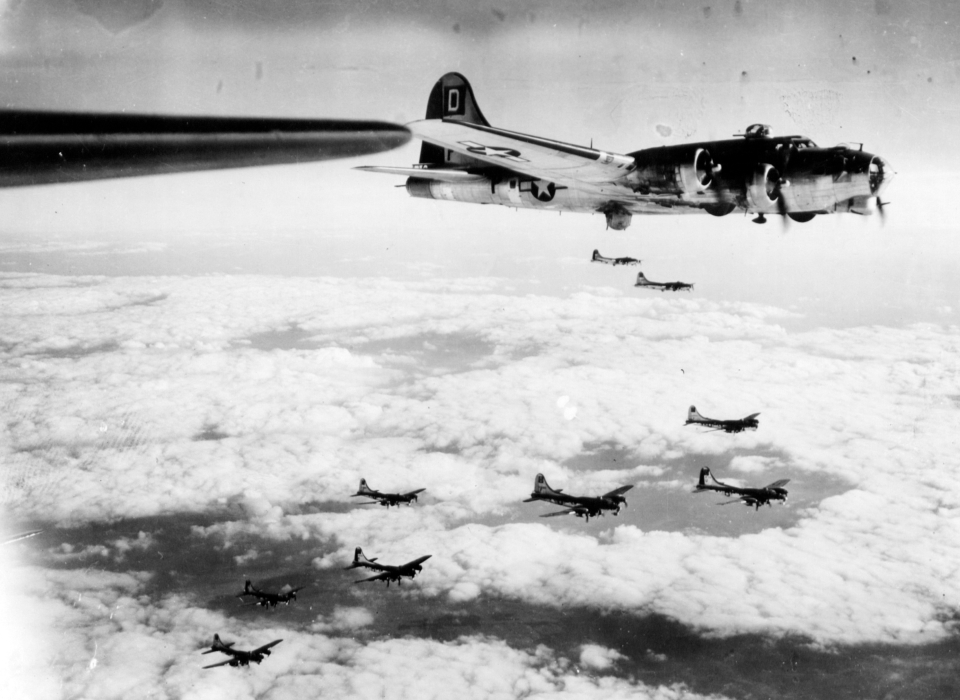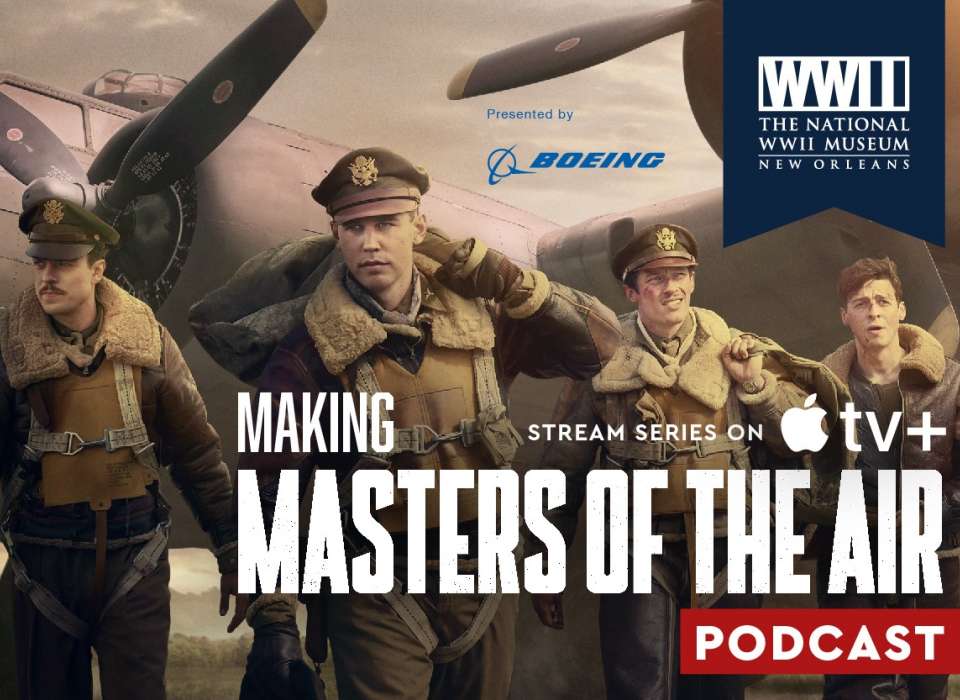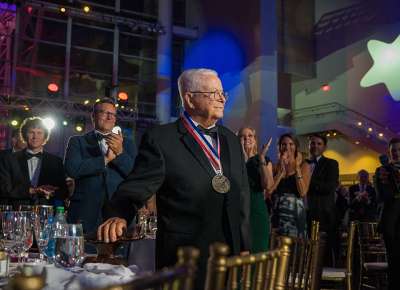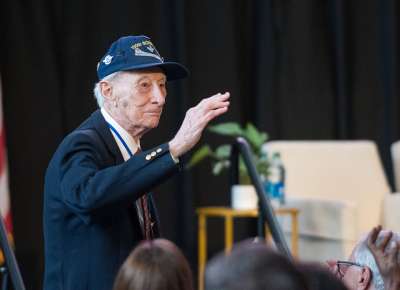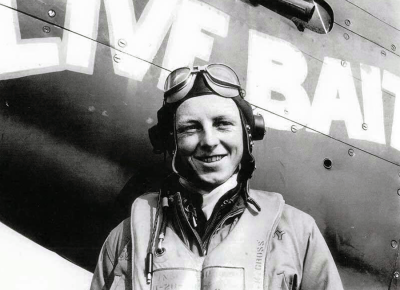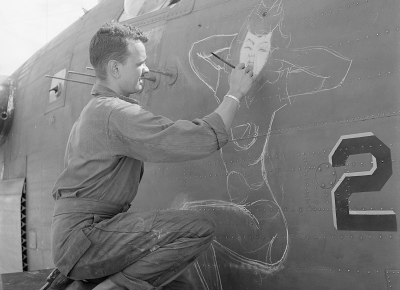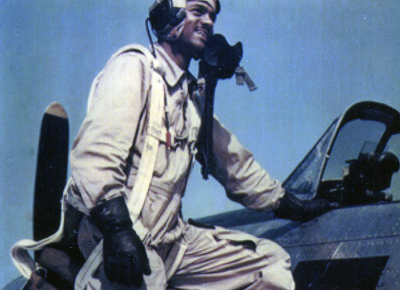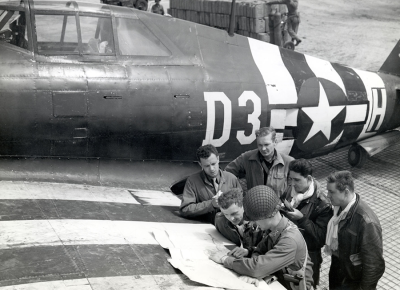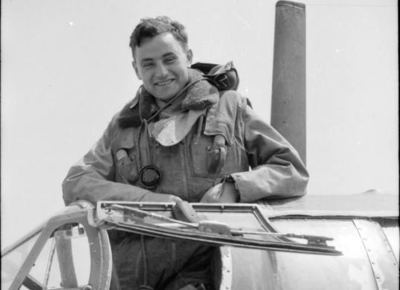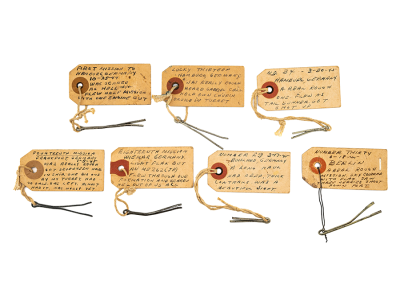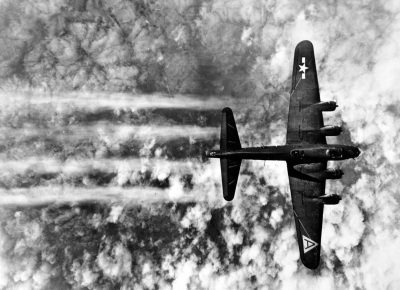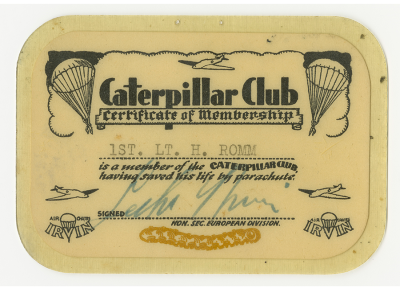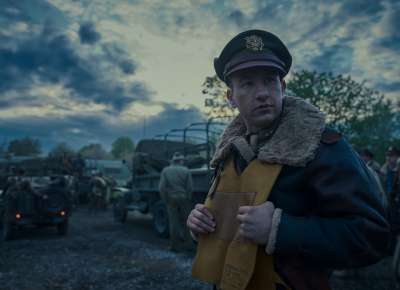Masters of the Air Miniseries on Apple TV+
From Steven Spielberg, Tom Hanks, and Gary Goetzman—the producers of Band of Brothers and The Pacific. During World War II, airmen risk their lives with the 100th Bomb Group, a brotherhood forged by courage, loss, and triumph.
Starring Austin Butler, Callum Turner, and Anthony Boyle.
All episodes streaming now on Apple TV+.
Meet the real-life airmen who inspired the series in the new documentary The Bloody Hundredth, narrated by Tom Hanks and featuring Steven Spielberg.
Making Masters of the Air Podcast
Join The National WWII Museum each week for the Making Masters of the Air podcast presented by Boeing to dive deeper into the making of Masters of the Air and explore the history behind the Apple TV+ series. The Making Masters of the Air podcast is co-hosted by Playtone’s Kirk Saduski and Donald Miller, author of the book Masters of the Air.
All podcast episodes now available!
Subscribe now via Apple Podcasts or Spotify.
Conference Session: The Making of Masters of the Air
Get an inside look at the making of Masters of the Air from Playtone producer Kirk Saduski and author Donald L. Miller, who served as historical consultant on the miniseries.
Watch their discussion from the 16th International Conference on World War II here.
Read the transcript for Making of Masters of the Air here
Kirk Saduski: There’s a line after the conclusion of that first scene between Cleven and Egan, and Cleven says to Egan, “This is it. This is it pal. This is it.” We’ve been working on this for over 10 years. And I know the theme is the Making of Masters of the Air. We can’t talk about the Making of Masters of the Air without talking about the writing of Masters of the Air. And I will get into why we chose Don’s book and all of that. But I am curious: You and I have spoken about it many times, including earlier today, but tell us. Why did you write Masters of the Air? What prompted you?
Don Miller: Well. I’m not a trained military historian. I was a philosophy major as an undergraduate and graduate school and become interested in what’s called intellectual history. And my first books were about cities and the Great Depression. And I didn’t get around to military history until the fifth book. And that was shortly after my father died, and I really felt a lot of guilt that I had never did his war.
He served with the Eighth Air Force, and I grew up in a military family. Everyone in our neighborhood, everybody, all the men, every single person on our block served in the war. And Memorial Day, Flag Day was a big day, go up to the cemetery, do the 21-gun salute and things like that. So, I had to do it.
So, I started out with a book called The Story of World War Two. I thought I’d learn about World War Two by writing about it. And then I did a book on the Pacific and then looking for another topic. And what really pulled me about the war was the combat experience and how people hold up under tremendous stress – the stress of aerial combat, ground combat, naval combat. To get into the book, to you had to have been at the point of the spear in combat, and that meant civilians under the bombers.
And as you know, there were more civilians, there were more noncombatants killed in World War Two by far than combatants.
And I came across a book by an Air Force psychologist – Gingrich – and it’s not the kind of book a layman would read. It’s a big tome, about 500 pages, and it’s a series of case studies by an Air Force combat surgeon who flew with the crews and treated them for what was called the combat fatigue, or post-traumatic stress disorder. How did they break down? Why did they break down? How do we treat them? Can we cure them? Did we cure them?
There’s a series of case studies and it was enthralling. Really, one after the other. And then I came across some numbers. You know, the Eighth Air Force had lost 26,000. This is an outfit of 280,000 total in the war. They lost 26,000 killed and 28,000 prisoners of war.
Now, put that number of 26,000 against this: The Marine Corps in the entire war in the Pacific lost 18,500 men from Guadalcanal to Okinawa. And this small bomb group took these kinds of casualties. Your chance of surviving in early missions were one in five. If you got to litereally the sixth mission, you had about statistically a zero percent change of surviving. 77 percent of the men who flew with the Eighth were casualties. So, that was just unbelievable. And, so, that launched it really. And then meeting with the veterans, going down to Savannah to the Eighth Air Force Museum to a reunion and meeting some of the really really great guys and finding out they were real human beings as well.
I met this guy named Louis Loesky. Somebody recommended him and Louis was a POW during the war. Jewish fellow, tough guy from a real tough area of Camden. Camden’s a tough place. I once told a cabbie that my granddaughter taught in Camden, and said she lived there. He said, ‘Is your granddaughter a missionary?’ I said, ‘No she’s not. She’s not a missionary.’
But Little Lou comes bounding in the room. He weighted about 125 pounds. He was about 5’4” and I’d never met in him in my life and told him what I was doing. And he said, ‘I can do 100 pushups.’ I said ‘That’s great’ And so down on the floor he went and I don’t know how many he did, but he did a lot of them.
And then he told me this amazing story, which shows you that these guys had a human side and sense of humor and a humanity about them. He wasn’t just there to tell me grim stories about combat. I said, ‘Let’s talk about your first mission, because that was your last mission.’
He said, Yeah, I got shot down on my first mission. I was a navigator.’
‘You’re coming down in a parachute over Berlin, and you’re a Jewish kid and you have a dog tag that has an H on it for Hebrew. He said, ‘Yeah that was a big decision, whether I was going to throw the dog tag away because it had an H on it. Or I could be in a lot of trouble if I filed it down. I did have a file; I could have used a pocketknife. I could have done that. But then, if I’m caught trying to evade the German air police, I’ll be shot as a spy.’
So, he kept the H on there. But he said that wasn’t my major concern. And I said, ‘Well, what was your major concern?’ He said, ‘You know, I was really worried about my mother. When you’re hit in a plane, the minute you’re hit and reported lost, whether you’re killed or not, they strip your bed, they strip your locker and they send everything home. And I had in that locker something I had bought before I came over here. I had bought some contraceptives.’ And he called it a ‘gross of rubbers.’
I said, ‘Okay. You were worried that they were going to go in the chest and your mother was going to open it up and say, I raised a sex maniac.’
He said, ‘That’s what I was worried about primarily, but I thought maybe the guys back in the barracks would find them and remove them from the thing, which they eventually did. ‘ But Lou didn’t find out until he got to the Stalag.
And I said to him, ‘With that many contraceptives, man, you must have been sexually alive!’
He said, ‘No. I was a virgin. But I was very hopeful!’
Kirk Saduski: Lou, Loevsky. How am I going to follow Lou? I don't know. So, as I said, we’ve been working on this for quite a while, over a decade. And initially we were working with HBO. We, Playtone – the company I work for – produced Band of Brothers and then produced The Pacific, and HBO came to us and said, ‘You know, we want to do another one. We want to do another World War Two limited series.’ And we knew we had done the paratroops; we had done the Marines. And we thought, okay that leaves the Navy, and it leaves the Air Force. How are we going to do that? How are we going to make that choice? And then for a minute, we dreamed and thought somehow we could combine them. And I remember talking to you about that in those early days. And of course, that was impractical. There was no way you could dramatically do justice to either story, nor afford to do it. And, we, Playtone, were familiar with your book. And so after reading it closely, it became very apparent that this is the story. If we’re going to do the story of the war in the air, that Don’s Masters of the Air was the way to go. Because, as he was saying, not only is there that kind of human detail that makes up stories. But Don created, and has created an entire world that you get a sense of what it was like to be on a base, and what it was like to be in a B-17, what it was like to be under bombardment by a B-17.
So that’s why we were so attracted to, the overall and that there were individual stories. And as you make it so clear in the beginning of your book, this is a form of combat that had never happened before and will probably never happen again. It was a unique experience. So how did we, how did America respond to that institutionally in terms of the Air Force? And how did primarily men respond to that individually? And that’s what Don does constantly through the book.
But this is a history of the Eighth Air Force during World War Two. That’s an enormous subject. How do you narrow it down? How do you tell a cohesive, coherent story that just doesn’t ramble all over the place? You open your book with talking about two characters, essentially: John Egan and Gale Cleven. And when we read Masters of the Air, he literally opens his book with John Egan in London. We read that story in your first part is about the 100th Bomb Group. And we knew that we had our version of Easy Company in the 100th Bomb Group, a group of guys who didn’t know each other before the war, wouldn’t have occasioned a cup of coffee at the beginning of the war. And this is true for Cleven and Egan, would have died for each other at the end of the war. Why did you choose Gale Cleven and John Egan to focus so closely on?
Don Miller: Well, the thing that kept the crews together was love. I don’t think you can fight a war without love – the love the comrades have for one another, especially, you know, in the foxhole. And they had that kind of strong relationship, and they were true leaders. And men under stress needed that sort of thing.
Bomber pilots are very different from fighter pilots, and they’re picked to be different. Fighter pilots for their craziness and their risk, think of Chuck Yeager. And Bomber pilots for their steadiness and their commanding presence, their measured personalities. And they have a whole crew to take care of, not just the Germans. They got to keep that crew together under tremendous stress. And I knew that the men at the 100th Bomb Group, from reading accounts, just worshiped these guys. And I thought it’d be interesting to tell their story because there was a juxtaposition there that didn’t work.
They were totally unalike. Cleven didn’t like athletics. He didn’t like baseball. He didn’t drink, he didn’t carouse. He was a one-woman man. He had a girlfriend back home. And Egan was exactly the opposite. He was in the bars every night raising royal hell. He was a character out of Damon Runyon, and he read all the Damon Runyon works and tried to even talk that smart Alec Fifth Avenue accent. But totally different guys, and yet they bonded so closely together. They both get shot down just about the same time.
When I open the book, Egan is in London on leave. It had just gone through an absolutely catastrophic mission, harrowing mission. And he goes out to buy a newspaper after breakfast and he reads that 100th had hammered Bremen. But then he sees that like 40 forts were lost. So, he calls down to a little red booth and he calls in the code. He said, ‘Did we have a game yesterday? And the operations officers said, ‘Yeah.’ ‘How did we do?’ He said, ‘We didn’t do too good.’ ‘How many guys did we lose?’ ‘We lost a lot of guys.’ ‘What about the big hitters?’ ‘They’re all gone. They’re all gone.’ ‘Are we going to do it again?’ He said, ‘Yeah, there’s another game tomorrow.’ And Egan says, ‘I’m pitching.’ And he goes back to the base and he flies the raid against Munster. And that becomes a revenge raid.
And on that raid too was a character named Robert Rosie Rosenthal, who drew me in. He was the guy I most respected. I’ll give you a quick biography of Rosenthal, a Jewish kid from Flatbush. Loved the Dodgers. Poor family. Didn’t go to synagogue. He loved jazz music and would go to New York City to the record shops. He’s an all-American athlete at Brooklyn College. He’s terrific on the football and baseball team. He’s in their hall of fame in both sports. Went to law school. Aced it out, got the best job of anybody in his law school class, and was sitting at a desk when there is rumbling that the Japanese might hit somewhere in the Pacific. Then Pearl Harbor. On Monday, he’s at the recruiting station. Signs up, goes over. And, usually, these bomb groups go as a group. The 100th went as a group. So, he joined as an outlander. He’s a replacement. And so, he has to work himself into this thing. And when he’s there, he quickly rises to the top because he’s very disciplined, very cool under pressure, and a fantastic leader of human beings. But not boastful in that sort of way. He flies 25 missions and decides to re-up. He says he’s not re-upping because he’s Jewish. He knew about the camps. He said I’m re-upping because of Hitler. He’s a barbarian. And as long as he is running that country, I’m flying my plane. He goes for another 25, is shot down and captured by the Russians of all people. Taken through Moscow, tried to get back to the war. He wanted to serve in the Pacific. They sent him back home. He went back to his old law office and said, ‘I am bored to shit here.’ And compared to the war, this is a job, the supreme job of my life. It’s just shuffling papers. So, he reads about the Nuremberg trials and they need trial lawyers. He signs up. He boards the ship to Germany and meets a young Navy lawyer, Phyllis Heller, and they fall in love. Rosie said, ‘I didn’t know whether I was in love or I was seasick, but it was really working.’ Phyllis prosecuted the prisoners. She prosecuted the Nazis who persecuted the prisoners that ran the oil and chemical plants in Austria and Hungary. Rosie helped prosecute the German civilians who had committed atrocities. He interviewed Keitel, he interviewed Jodl, interviewed all the Nazis. And he interviewed Hermann Goering before suicide.
And he wanted to go to the hangings. He thought that would be closure. He said when he saw these barbarians reduced in ciphers in prison closing, depressed, red sputum coming from the side of their mouth. They know they were going to be hanged. ‘When I saw that, it was closure for me. Phyllis was pregnant, and we had to go home, and the trials were over.’ He told me that story when I first met him. I had to pull it out of him. He never wrote about it. I had a character there.
Kirk Saduski: You had a hell of a character there. And I think that’s what really, once we decided that it was Don’s book and more specifically the 100th, and just as you describe it becomes very obvious very quickly. Initially it’s Egan and Cleven, and if anyone’s familiar with Greek mythology, they pretty much reminded us at Playtone of the most iconic friendship in Greek mythology: Damon and Pythias. They really are very much like that. But then we knew that we wanted to be more than just the story of these two guys and the friendship. It had to be a little bit wider. So, who else could we focus on? Don just told you; it was Robert Rosie Rosenthal. Because if Cleven and Egan are Damon and Pythias, Rosie was Sir Galahad, the perfect knight, the perfect airman, the perfect warrior.
Don gave us these characters. He gave us this world. And then, of course, we have to do it. In the clip you saw, Major Gale Cleven is played by Austin Butler and Major Egan is played by Callum Turner who will be in a movie that’s coming out in just a couple of weeks, Boys in the Boat. He’s the star. I think you’re going to see a lot of Callum. And then Rosie, as is portrayed by Nate Mann, who is terrific.
In Band of Brothers and The Pacific, we got to know, I got to know, Playtone, Gary and Tom got to know a lot of the men that we portrayed, certainly in Band of Brothers. There were dozens of them from Major Winters, to Sergeant Guarnere and Lieutenant Lipton. And then The Pacific, we got to know quite a number of the guys as well. Unfortunately in Masters of the Air, none of the men that we portray lived. So we never got to meet them. We did meet some members of the 100th who knew them, but we didn’t get to meet them. So, it took a lot of research. Who were these guys? And I know we’ve worked very closely with all the families. The Rosenthal family, the Crosby family. Harry Crosby is our fourth leading character.
I want to go back to Rosie for a minute. When you hear about him, when you talk to his family, when you read about them, when you talk to the men who served with him, you realize what an extraordinary man he was. And Nate got the opportunity. We shot the entire show in England, and at one point Dan Rosenthal brough his son Sam over. (Dan is Rosie’s son). We were able to introduce him to Nate, and you could immediately see that Dan recognized something in Nate that was innate in his father. You came over to England for a while. You spent some time. We were in England for, I want to say, about nine months. We had four primary big locations. Each location was almost the size of a small municipal airport. It was a very complex production, and we were doing it in 2021. So you know what that means: We were in the middle of COVID and that complicated things in a away that in other productions we didn’t have to worry about as much.
Don Miller: The sets were staggering. When I heard that Steven Spielberg was going to create a barracks from the stalag, Stalag Luft III, which is in Żagań in what was then Germany where our airmen were positioned for the rest of the war after they were shot down. I thought, one barracks. But it was an entire camp. I thought, ‘My God!’ And then I went over to Oxford, and I saw in Abington and at the station a place called Thorpe Abbotts, a bomber base, 2,500 people in the base, intermixed with locals and foreign people working their lands while planes were flying. You guys had recreated Thorpe Abbotts.
Kirk Saduski: I will say that one of the interesting, and one of the reasons that I think hopefully this series works is the devotion to detail that everyone in the production paid. You saw it. One of the best days we had was at Thorpe Abbotts, the air base that the 100th flew out of, is currently a museum in East Anglia. And it’s all run by locals, its volunteers and it’s obviously a work of love for them. And one day we were able to bring Debra Hubbard, who runs the museum, and her staff, some of whom would have worked their since they created the museum. And to have them come in and see the briefing room, the Nissen huts. And one gentleman, Ron Baddeley, broke down because it was so authentic. And that is, in many ways, the key. It was one of the keys. There’s no one key, but the art department run by our production designer Chris Seagers and the costume department and our costume designer, Colleen Atwood. On the tail of the B-17s in the 100th Bomb Group is a big D. The 100th is the ‘Big D.’ Well, the big Din our production is “devotion” – devotion to detail. Because it was, from top to bottom, whether you were the department head or were a seamstress, a prop master or PA. The devotion to tell this story correctly was absolute. And I think you will see that on the screen.
Don Miller: And I think that’s what I was worried about. You always worry, ‘Is your film going to be Hollywood-ized.’ I used to think things like that. I had a couple of conversations with Dave McCullough, who’s a very close friend for years. And these guys had done, and Kirk was largely responsible for getting Dave to do this with the John Adams series. And Dave said, ‘They’re the best. The get it right.’ And I remember our first meeting with Tom Hanks and he kept saying ‘Fidelity, fidelity. Everything has to be exactly as it happens. No composite characters. Every character has to be the character from real life. The names are the same. Everything that happens in that film has to have happened, and it happened in the way that we portray.
And he threw himself into this thing right quick. The anecdote to show you the kind of dedication that everybody had. Kirk was amazing. I think I refer to Kirk as a historian. He knew as much about the 100th as anybody when the time was done. But Tom flew in, I live in a little town called Easton, Pennsylvania -35,000 people, Delaware River. And Tom flew in one day. We were going to work at my house. Drove my wife crazy. ‘We’re going to bring in Tom Hanks. ‘Yeah, okay, we’ve got to buy this. We’ve got to buy that.’ But anyway, I pick him up at the airport. I said, ‘Tom, you’re only going to be staying for a couple of days.’ He’s got a couple of suitcases here filled with books. I said, ‘What are these books?’ He said, ‘The latest books on German history. You know, there’s all these fantastic historians writing tremendous books about Hitler. And I want to read them all.’ Plus, he said. ‘I have about 245 note cards that we’re going to go over this weekend. I said, ‘My God!’ Yeah. That was the kind of dedication as well.
Kirk Saduski: Tom’s devotion, obviously to World War Two and to this Museum is well known. I’d like to talk a little bit about some of the people involved with the show as well. I want to start with Gary Goetzman, who is Tom’s partner and has been this partner through Band of Brothers, through The Pacific, and everything Playtone has ever done. They’ve been partnered on everything. I will say, and I’m prejudiced of course, this has to be the most difficult production. I can’t imagine the scale and scope of this thing. I am not kidding when I say four municipal airports with many satellite locations. The logistics of this thing. And we’re still in post production, even though this thing is going to stream in a month and a half. We’re still fighting with it. And Gary has really been… He’s the Hap Arnold, the head of the entire Air Force. He’s the Hap Arnold on all of this project.
Don Miller: He's Ahab after the Whale.
Kirk Saduski: Fortunately for us, I think we’re going to catch this one now. There are so many people. I want to mention John Orloff who was our primary screenwriter. He wrote a couple of the episodes of Band of Brothers and when we invited him to come and join us, he threw himself into this completely. One of the things about adapting Don’s book is that there’s no one story. As I said, that’s the great thing about the book. It’s an entire world. John’s challenge was to figure out. We have to adapt it so that it’s dramatically coherent. We can’t portray everything. And John threw himself in and did the research and came up with and helped the characters, the Egan, Cleven and Rosenthal, who we didn’t get to meet unlike Winters and some of the other guys. John had to envision dramatically. And he worked for, I think, almost a year on just doing the research and putting it up and just putting that together. Don worked very closely with John.
Don Miller: He called me, and we talked for nine hours, just about Gale Cleven because it was serendipitous. It just so happened that I was the only person on the whole project that had met these guys. Everyone’s coming in, ‘Well let’s talk. What’s this guy like?’ I had to draw these mental kind of pictures and things because you’re the only one who’s met them.
Kirk Saduski: Let’s talk about them a little bit, and throw in Harry Crosby too, because we have a very important fourth member who’s in all our episodes. When we meet him, he’s Lieutenant Crosby. He ends up as a lieutenant colonel and he was a navigator. He was the one character that we have who was at Thorpe Abbotts from the beginning. The 100th was formed in Thorpe Abbotts in May-June 1943. Harry Crosby was there from the beginning, all the way through May 1945, and V-E Day. You met Harry Crosby. Tell us. And you’ll get to know Anthony Boyle plays a wonderful Irish actor, Harry Crosby and does a spectacular job.
Don Miller: Well, these airmen were wonderfully talented human beings. I mean, Gale Cleven went on to get a Ph.D. in astrophysics and became a college president, and he’s just a roustabout from Montana. Very interesting kinds of characters. Harry was bubbly, excitable, inefficient at first, scared out of his wits worried about his incompetence. And slowly, as the film evolves, you see him coming into himself. He falls in love briefly, and he has a wife back home. But he falls in love with this English girl. He gets to become a lead navigator, a tremendously responsible position getting the bombers to the target to they can do the bombing. And he works himself into such a tizzy before D-Day that he passed out and slept for three days.
Kirk Saduski: Yeah. Don’t give it all away!
Don Miller: Harry had a sense of humor. And his book A Wing and A Prayer is terrific. And it gets you into the internalities of what it’s like to be on a bomber base, which is a community. It’s integrated with the villagers and they’re a part of the story in the film and in my book, as are the people of London and the Germans under the bombs.
Kirk Saduski: When you undertake a project like this, you can’t just go ‘this happened and that happened.’ There has to be some thematic consistency. I think there were too primary themes in our series. And Don has already touched on. It’s the irony that war is impossible without love. You hear this time and time again, whether you’re talking to somebody from the 1st Marine Division or Easy Company or on a destroyer in the Pacific. Why do they do it? They do it for each other. Ultimately, at the end of the day, they do it for each other. War is impossible without love of men for each other when thrown into those circumstances. The other theme is how did those men keep getting back into those planes after you’ve been on a mission, after you’ve seen Regensburg, and after you’ve bombed Regensburg and Munster and Bremen and etc. How do you get back in that plane? And yet they did , time and time again.
Don Miller: Exactly. I wanted to get away from this bullshit that this is push button warfare. You’re just up there, you don’t see the victims, you press a button, you bomb people. And that’s very different from infantry. Most of these airmen who would talk to infantry men. My uncle was the first division in the first two minutes of D-Day, the Big Red One. And as I said, my father was in the Air Force and my uncle flew with LeMay and the fire raids. But the infantrymen were always awed by the bombers flying up there with all that gasoline and a thin little tube that if you had a strong arm and a screwdriver you could drive a hole right through the outer fuselage of the plane, the skin of the plane. The flak comes right through.
And what we wanted to do is take you in this film inside the plane. Not do dogfights and things like that on the outside. Kind of a different kind of Tom Cruise film. I had written about these missions, and I knew they were harrowing. But when you see them reproduced, I remember the first time I saw Jaws and I jumped out of the seat. I jumped out of the seat in this thing. The panic and fury and chaos that takes place. It’s 10 guys inside a plane and they’ve been hit. Two engines knocked out, maybe three engines knocked out. Fog, two gunners, three gunners who may be out. The pilots been decapitated. No medics on the plane. No foxholes in the sky. Where do you go? You go to tend your comrades. All you have is some morphine. Shoot him with morphine, put him on the cold floor of the plane, get a blanket over them. If they’re too banged up, wrap them in a parachute, throw them out. I’ve got to take care of this guy over here. He’s really hurt. My best buddy’s hurt too, but he’s hurt worse. They both have a sucking wound. If I pull the pressure back, they die. All the time the plane is shaking like hell and there’s this smell of piss and shit and cordite and everything. Smoke all over the plane. And all that time you are being hit by 125 fighter planes coming at you from every direction. And you got to man the gun and get the plane back. When you see that reproduced, it’s unbelievable what they suffered. And they were so close to the Germans. The Germans came in so close they could see the eyes of the pilots. And I talked to some of the guys who fought in the Pacific and they said ‘we never get that close to the Japanese.’ They could see their eyes and they certainly saw the Germans in the camps. But that’s what really impressed me.
And quick note on that, the cameraman had a tough time moving around inside the constricted fuselage, which is much more constricted than a submarine tube. And Spielberg built two B-17s from scratch. Amazing project. Eleven months they stayed in England, and he built a third one that had a wider body. It allowed the cameraman to go inside the plane and film, close up, the kind of things that I’ve described.
Kirk Saduski: Well, I know you’re not trying to suggest that Steven Spielberg crawled into these planes and build them. You’re obviously using Steven Spielberg and Tom Hanks and Gary as a symbol representing the works of hundreds of people.
What kind of separates it from just another adventure story, just another story of combat is providing some kind of context without being didactic about it. And that was a really big challenge because at the end of the day, why are these guys doing this? Why at the end of the day, they’re dropping bombs that are going to kill women and children? There’s no way around that. So why and how do you do that without lecturing? How do you suggested that without lecturing, without being didactic about it? It’s integrated into the themes of the end, the drama of the story, without being separate from the story. Don and I could sit up here and talk about this all night, because we have done it all night many times. But I have a feeling there may be a lot of questions.
Don Miller: I just want to make one point, because a lot of people here are writers, and you’ll know that one of the central dilemmas that we faced was how do you move the story along dramatically while building in interpretation without having the interpretation slow the narrative. That’s hard to do, as all of you know, right?
Kirk Saduski: You don’t have time to stop and explain who the Nazis are, what they did, why they had to be beaten. You can’t do that. You have to keep going. Once you’re on them, once you take off, you have to keep going.
Audience Question 1: Gentlemen, thank you for a good presentation. What I’d like to ask is, you mentioned that a number of B-17 were scratch built for this production. How many real B-17 were used in the production?
Don Miller: None.
Kirk Saduski: Yeah, there were none, for numerous reasons. That was never practical, was never considered. There were three B-17 that were built, but they didn’t fly. They were three replicas, one of which that could actually be propelled forward. You couldn’t shoot inside a real B-17. You wouldn’t take people up. And it was just never a consideration. But again, like I said before, the devotion to recreating the B-17 down to the smallest detail up in the flight deck, in the nose, in the fuselage was extraordinary. I’ll have to say. That sense of authenticity was essential to everybody doing their jobs. It was inspirational. It was inspirational to work on the show, not just because of this. It was what the men deserved. That kind of dedication from everybody, no matter whether you were Austin Butler or Callum Turner or you were a set PA. To have that kind of dedication, the men deserved nothing less.
Don Miller: I was sitting where they were filming a briefing in the briefing room before D-Day. Rosie explains that they’re going to finally hit Omaha Beach and there’s cheering and things like that. And I was off camera, of course, in an office that had an open window that could look out onto the set. And I saw a stack of papers there in a file box and just went through them. And I picked up the bottom one and it was an actual Air Force communique. And I picked up the next one. It was official Air Force business. They could have put advertising for, you know, Campbell’s Soup in there. And you go into the bar and check the labels on everything. The absolute fidelity, absolute accurate and authenticity.
Kirk Saduski: Playtone would never do it otherwise. It’s the only way you can really do it. And again, to have the kind of impact that we know we have had with the other two series and hope to have with Masters of the Air.
Audience Question 2: Dr. Miller, could you talk about your father’s service with the Eighth Air Force and how it affected him during the war and afterwards?
Don Miller: Well, not really. It would take us a little bit away from the story here. I would be glad to talk to you in private about it though.
Audience Question 3: In the clip you showed us, there were scenes of firefights and dogfights and all kinds of things in the air. How were those produced?
Kirk Saduski: Without getting into too much technical detail, most of it, a lot of it is done post-production. In fact it is still being worked on in the visual effects. So much of that is computer generated and created by our special effects supervisor Steven Rosenbaum, who like Chris Seagers and Colleen Atwood is the absolute top of their game. In terms of the B-17s and P-51 that you see with the Tuskegee 33nd guys, we had the fuselages and they were on a gimbal. They were filmed in something called the volume, which is essentially hundreds and hundreds of video screens that recreate the environment outside the airplanes. Because they’re on a gimbal, they can move. So that helps the actors. Primarily the dog fights, the air combat, depending on if it particularly was in the exterior of the planes, is all done through special effects.
Don Miller: And the B-17 that we had, we can move them around the area on the base, and we even had one landing. There’s one scene of one landing and the propellers worked, and they built these enormous cranes with wires on them. And you see this thing coming in and you don’t see the wires. And you see it landing and it looked like it is an actual B-17.
Kirk Saduski: The logistics side, as we suggested, were enormous.
Audience Question 4: Don, you know better than anyone else the controversies over the effects or the uses of air power in World War Two. It’s a big question, but how do you think about the contribution of air to the war? What effect did these heroic figures have on the outcome of the war?
Don Miller: There were several bomber wars and they had various stages. In the beginning, just to go through quickly, the beginning bombing was catastrophically ineffective. We were bombing submarine pens and so on, and the bombs bouncing off German reinforced concrete storage places like ping pong balls. And the city they were bombing were called Flak City and they were losing planes. That’s the 12’o’Clock high story about how do you keep them motivated when they’re not carrying out the mission. They were going to the target and they’re getting hammered, the bombing was ineffective and the casualties were calamitous.
So we evolved from that in the story to the point where they’re doing serious damage on the German economy, to the point where in October 1944, German oil production was down to 6 percent. That’s when they learned how to hit German oil by killing it by a thousand cuts. The idea of pinpoint bombing is an oxymoron. It doesn’t exist. And you don’t knock out a plan with one raid. You had to go back and hit it, hammer it again and again. One particular plant in central Germany they hit 120 times. 120 separate strikes to knock it out.
We start bombing the center of cities because we’re hitting the one target that really works: that is the marshalling yards for all of these trains gathered together. So you don’t have to hit the jet production factory or the electrical system. It’s all there.
Kirk Saduski: Another area that is really germane and where the air power was so effective was the build up to D-Day. In all the time I’ve been with the Museum and all the World War Two history that I’ve read, I never quite understood. And it was really one of your central points was that the Eighth Air Force just doesn’t get enough credit for the success of the Normandy invasion. For the invasion to work there had to be really essentially no opposition and complete air supremacy. And so, for a month, starting in January 1944, the Eighth Air Force’s main target was actually the Luftwaffe.
Don Miller: The fact that there was no opposition from the air on any of those five beaches on D-Day is the greatest testament to their success. The Germans continued to produce machines, airplanes, but they didn’t have the oil because we were hammering oil. And they did not have the pilots. The pre-D-Day raids were pilot killing campaigns. They wanted to kill as many skilled German pilots as possible. And they did.
They killed 76 percent of the Luftwaffe pilots. And they did it in such a way that was crazy. They used the bombers as bait. They knew a primary target like Berlin, Hitler had to defend. And we finally had a plane that could handle anything the Germans could throw up, we had a P-51 Mustang, faster, more nimble and with fuel capacity to fly ahead of the bombers all the way to Berlin so you could escort the missions into Hungary for that mattery. So we wanted a mess. We wanted the Germans to mess with us. So we flew these missions to bait, and the Germans took them up. The bombers flew dedicated missions. Every time they were in the same route, no diversions. Carl Spaatz, which was the head of all air forces in Europe sent them in the same way and he upped the missions from 25 to 30 and then to 35 while he’s doing this. And the bomber guys knew they were up there as bait and they knew they were going to kill a lot of civilians because Berlin didn’t have the kind of targets that we were looking for. This was going to be a different kind of bombing.
When I walk on the beaches of Normandy, I think of the 18,300 British and American crews and pilots that were killed in the three month run up to D-Day against a little less than 5000 killed on the actual D-Day. And yet you never hear this mentioned anywhere. And as Kirk said, there is no D-Day if the Germans are there. The Normandy invasion fleet doesn’t sail out unless we have air supremacy. And once we have air supremacy, we can go after major industrial targets.
Kirk Saduski: And in what Don was talking about in terms of the psychological attrition, when there was a period when a lot of guys are aiming for 25 missions, and all of a sudden, well no, it’s actually 30 missions, or you know what, on third thought it’s 35 missions. They weren’t told, but they quickly inferred that they were being used as bait to bring up the German fighters. So that’s the kind of psychological human drama dilemma, a conflict you need to build a dramatic series. So again, its not just another adventure story.
Don Miller: You’ve got to pull these guys off of the line and send them to what they call Flak Houses, estates that are donated by the British aristocracy. And they can go there and run with the hounds are play archery or whatever. That didn’t work. But as guys start to break down, they realize they have a mental problem of major proportions. Actually, it started in North Africa when over 30,000 cases of combat fatigue, as it was euphemistically called. The British called it, roughly, a lack of moral fiber. Ohh. That’s a tough one.
Anyway, how you treat these guys, to get them to fly again is a big dilemma. They’re working with the doctors and some of the doctors and the chaplains are saying ‘why should we fix up these guys mentally? Why should we get them right to send them up in the planes in the same conditions that brought them here in the first place? I’m sending a guy on a second suicide run by curing them. So there’s that kind of dilemma. They started using drugs and use depth psychology to try to pull the demons out of them, get them to relive the missions that were calamitous psychologically for them. That shook them to their core and that did no good. It made them worse. The only thing that could cure them was to say you don’t have to fly again. But this is a real problem that the Eighth confronts in there, and we try to show it in a muted way. I think in the film, we watch our guys slowly display these kinds of characteristics of combat stress, which is different than the kind of stress that combat veterans on the ground have. It’s completely different symptoms.
Audience Question 5: I’ve been a teacher, and I’ve seen the kind of demise of our history in the public school system. And so one thing the kids will want is a film or, you know, go to the movies. But if it’s a video, they watch it. And the fact that this is a true story is really a way to communicate with young people the hell of World War Two. My question is, however, how much does this cost?
Kirk Saduski: Yeah. We can’t say, well.
Don Miller: Let’s just say we’re overbudget.
Kirk Saduski: Thank you for the comment. And I think it's fair to say it may be the largest television production of all time. We'll leave it at that.
Audience Question 6: One of the issues with making war movies or a series is the age of the actors compared to the characters who they play. I remember Tom Hanks being a 40 year old captain in Saving Private Ryan when he would have been 24. How’d you guys do in that respect?
Kirk Saduski: I think we run into this in every one of the series and one of the considerations was about the young men of that time growing up in the Depression and then serving in the war. That 24 then almost appears like, I don’t’ want to say 34 today, but certainly older. 24 today is a bit different because of just life experience and that was expected. So you end up for a variety of reasons casting older than actual roles, but you could. When you look at archival footage of World War Two, you just don’t think you’re looking at 19 year olds, although you are. When you look at the World At War or some of the Ken Burns stuff, they have men who are 22. I’m not sure you would buy it, that that kind of responsibility would b e handled by a 25-year-old. So you tend to cast a little older.
Don Miller: I just want to make one comment about, I was really impressed by what you said about dedication, because that’s what hit me. The dedication and commitment of the crew members. I’ll give you one little anecdote. I was working with Tim Van Patten on the last of the ninth volume. And this is a guy that’s won Emmy after Oscar after Emmy. He’s the best there is and in a lot of ways is a great actor. And he sat me down and he said, ‘I read your chapter on Moosburg’ which is this gigantic catch basin of a prison camp with 100,000 people in. The Germans were moving not just the Jews but the prisoners of war to the west. And the American infantry invade that area. There is a big firefight outside of Moosburg and then it spilled into Moosburg and then into the camp itself. There’s chaos and everything else. Anyway, Patton comes in and liberates it. So Tim says, ‘I’ve read the chapter, but I want you to tell me about it.’ Now I sat there for six and a half hours and told him every detail. He didn’t take notes, but it was like registering. And he said, ‘Can you come back tomorrow morning, pretty early?’ I said, ‘Well, how early is it?’ ‘Like 6 am?’ ‘Yeah, I’ll have my driver bring me back over to the main studio.’ So I got there than his assistant said, ‘He wants you to close your eyes and then go into that room.’ I went into the room and he had a marvel of tanks the kids play with and flags and troops and everything. With planes coming in. It was like something you had for Christmas under your tree. And I said, ‘How did he get these toys in the middle of the night in London?’ He said he was banging on the doors of shops and things like that. I think the shopkeeper opened the toy store, let him in there and he bought all this stuff.
Kirk Saduski: It's the dedication because he did that in detail. He wanted to show it to you because he only understood it through your words.
Read Masters of the Air
With the narrative power of fiction, Donald Miller takes you on a harrowing ride through the fire-filled skies over Berlin, Hanover, and Dresden and describes the terrible cost of bombing for the German people.
Purchase your copy of Masters of the Air here from the Museum Store.
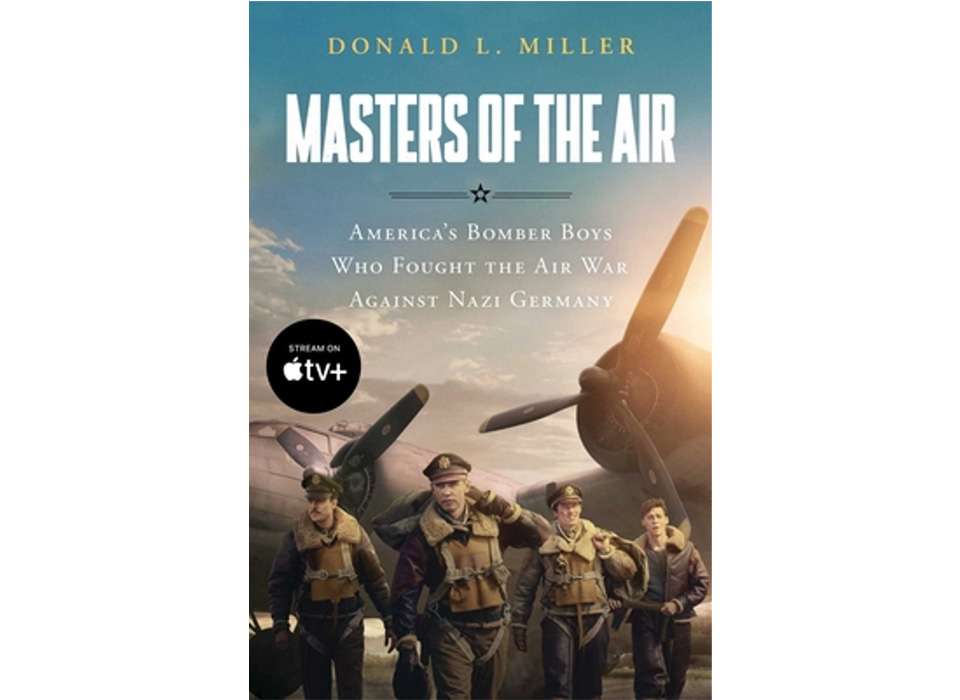
Dig Deeper on the Bloody 100th Bomb Group
Learn more with articles on the air war in Europe, aircrafts, and the American bomber crews who risked it all.

Masters of the Air Related Videos
Watch videos about the air war in Europe and listen to oral histories and firsthand accounts from WWII veterans.
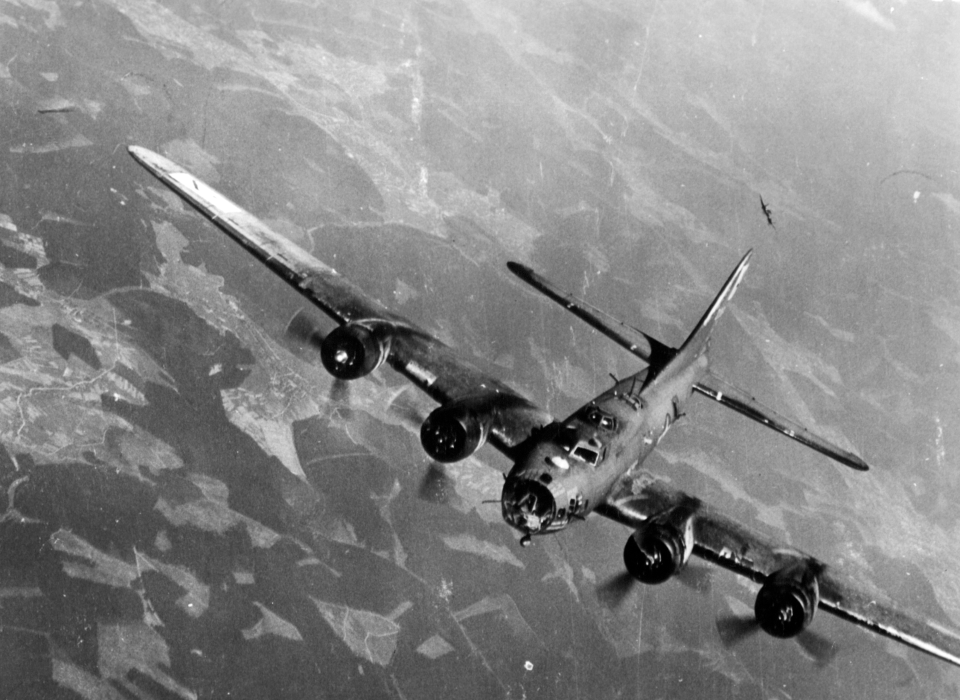
Masters of the Air Tour
Masters of the Air is a story of life in wartime England, in bombed-out London, and in the tiny hamlets these brash young Americans completely transformed. In East Anglia, many airmen fell in love with British girls they met in the local pubs, and over 45,000 American servicemen brought home English brides after the war. The beautiful countryside and stately manor homes give way to the remains of air bases, some of them with their control towers still visible on the skyline.
Learn more about this trip of a lifetime here.
